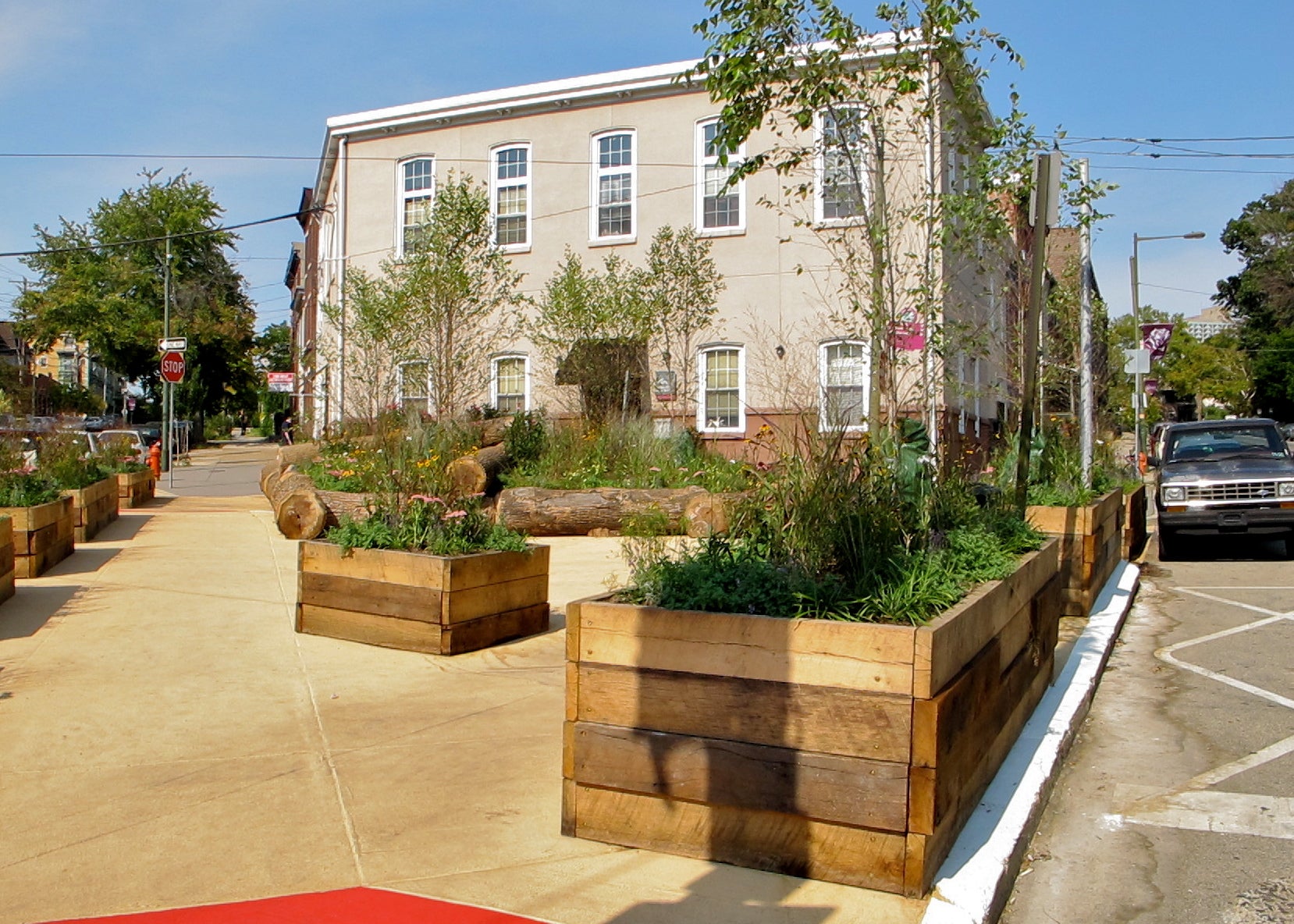Woodland Green brings rustic flourish to University City intersection

At the intersection of 42nd Street and Woodland Avenue tall grasses and river birch trees swish in the breeze, and felled logs are habitat for native flora and fauna. This is not some lot gone to seed but Woodland Green, University City’s new pedestrian plaza set to officially open today.
University City District (UCD), the Mayor’s Office of Transportation and Utilities (MOTU), and the University of the Sciences of Philadelphia (USP) partnered to create the new plaza. Prema Gupta, Director of Planning and Development for UCD, and Andrew Stober, Chief of Staff at MOTU, met me at Woodland Green this week to show me around and talk about their collaboration. Here’s what it looked like during our visit:
UDC worked with Think Green, a sustainability-focused design-build firm, to transform the once-useless stub street and triangle into a playful take on an urban meadow. Standing in what will be the plaza’s central seating area, Gupta explained that UCD wanted to improve this important gateway for University of the Sciences and beautify the Woodland Avenue corridor.
“We wanted it to have a very rustic feel,” Gupta said. “We thought that would be a little bit unexpected given what the site used to be.”

Tall wood planters frame the plaza, partly constructed from thick, rough joists salvaged from a building renovation in University City. The plaza’s marquee landscape feature is set back toward the University of the Sciences’ East Building: a hulking, tiered planter was built using large, joined logs, some of which were reclaimed from tree work at The Woodlands just across the street.
Think Green helped develop a planting scheme “that would take minimal maintenance and with an eye toward native species,” Gupta explained. “We didn’t ask for the honeybee habitat but we are very excited about it.”
During our visit on Monday we saw plenty of honeybees (likely visiting from the apiary at The Woodlands) stop by to snack on sedum, as butterflies flitted around the flowering plants – including pink shrub roses, purple coneflower, white Shasta daisies, Black Eyed Susan, lavender, catmint, Russian sage. Rounding out the plantings are ornamental grasses and eight wispy river birches.
To Stober the design succeeds in making “this previously very well defined space look like something a little bit more organic.”
The only thing missing during our visit was the furniture: Three big yellow umbrellas and sets of red movable tables and chairs, just like the ones used at The Porch and in Clark Park.
All told UCD spent $50,000 on the project, $30,000 of which came from a MOTU grant, and the plaza took about one month to construct. Crews from UCD and USP will share responsibility for the plaza’s upkeep.

Woodland Green is just the latest on a growing list of collaborative projects between MOTU and UCD. When I asked Stober and Gupta why UCD and MOTU are such frequent partners, they offer up complementary answers.
For it’s part, the city only has so much money to put toward pedestrian amenities, so it is critical that they work with capable partners to help develop smart projects, and then handle maintenance. In UCD, Stober said, MOTU has a partner with both planning and operational strength, a shared interest in making pedestrian improvements, and a willingness to experiment.
“We’ve found in University City that there is a very clear need for a wide assortment of pedestrian amenities,” and MOTU is there to help make those happen, Gupta said. “We’re really lucky to have such a progressive branch of city government.”
UCD and MOTU will work on another pedestrian plaza at 48th and Baltimore in the spring.
As natural as the partnership seems between MOTU and UCD, Stober stresses that opportunities abound for similar projects citywide. Pedestrian plazas like Woodland Green are exactly the kind of project the city would like to do more of: they’re not budget-busters, they’re quick to build, and rely on strong community partnerships. Plus, they’re good advertising.
“Every time we can show one of these innovations working and working well, it builds the demand for them,” Stober said. “This is a neighborhood where there are a lot of people from all over the city traveling through and they’re going to look and say, ‘I want one of those.’”
WHYY is your source for fact-based, in-depth journalism and information. As a nonprofit organization, we rely on financial support from readers like you. Please give today.





